Assessing Spatiotemporal LST Variations in Urban Landscapes Using Diurnal UAV Thermography
Abstract
1. Introduction
2. Literature Review
3. Methods
3.1. Study Area and Data Acquisition
3.2. Thermal Image Processing and Sample Collection
3.3. Outlier Management
3.4. Statistical Analysis
3.5. Spatial Autocorrelation Analysis (Moran’s I)
3.6. Geographically Weighted Regression (GWR) Analysis
4. Results
4.1. Data Pre-Processing and Outlier Management Across LULC Classes
4.2. Frequency Distributions and Descriptive Statistics Analysis
4.3. Trend and Correlation Analysis of LULC and Ambient Temperature
4.4. Spatial Autocorrelation Analysis (Moran’s I) Results
4.5. GWR Results
5. Discussion
6. Conclusions
Author Contributions
Funding
Data Availability Statement
Conflicts of Interest
References
- Meerow, S.; Newell, J.P.; Stults, M. Defining urban resilience: A review. Landsc. Urban Plan. 2019, 147, 38–49. [Google Scholar] [CrossRef]
- McPhearson, T.; Iwaniec, D.M.; Bai, X. Positive visions for guiding urban transformations toward sustainable futures. Curr. Opin. Environ. Sustain. 2018, 22, 33–40. [Google Scholar] [CrossRef]
- He, B.J.; Zhao, D.X.; Zhu, J.; Darko, A.; Gou, Z. Promoting and implementing urban sustainability in China: An integration of sustainable initiatives at different urban scales. Habitat Int. 2021, 82, 83–93. [Google Scholar] [CrossRef]
- Wang, F.; Qin, Z.; Song, C.; Tu, L.; Karnieli, A.; Zhao, S. An improved mono-window algorithm for land surface temperature retrieval from Landsat 8 thermal infrared sensor data. Remote Sens. 2015, 7, 4268–4289. [Google Scholar] [CrossRef]
- Yao, H.; Qin, R.; Chen, X. Unmanned aerial vehicle for remote sensing applications—A review. Remote Sens. 2019, 11, 1443. [Google Scholar] [CrossRef]
- Feng, Y.; Du, S.; Myint, S.W.; Shu, M. Do urban functional zones affect land surface temperature differently? A case study of Beijing, China. Remote Sens. 2019, 11, 1802. [Google Scholar] [CrossRef]
- Burger, M.; Gubler, M.; Heinimann, A.; Brönnimann, S. Modelling the spatial pattern of heatwaves in the city of Bern using a land use regression approach. Urban Clim. 2021, 38, 100885. [Google Scholar] [CrossRef]
- Chudnovsky, A.; Ben-Dor, E.; Saaroni, H. Diurnal thermal behavior of selected urban objects using remote sensing measurements. Energy Build. 2004, 36, 1063–1074. [Google Scholar] [CrossRef]
- Yin, C.; Yuan, M.; Lu, Y.; Huang, Y.; Liu, Y. Effects of urban form on the urban heat island effect based on spatial regression model. Sci. Total Environ. 2018, 634, 696–704. [Google Scholar] [CrossRef]
- Conti, S.; Meli, P.; Minelli, G.; Solimini, R.; Toccaceli, V.; Vichi, M.; Beltrano, C.; Perini, L. Epidemiologic study of mortality during the summer 2003 heat wave in Italy. Environ. Res. 2005, 98, 390–399. [Google Scholar]
- Davarzani, H.; Smits, K.; Tolene, R.M.; Illangasekare, T. Study of the effect of wind speed on evaporation from soil through integrated modeling of the atmospheric boundary layer and shallow subsurface. Water Resour. Res. 2014, 50, 661–680. [Google Scholar] [CrossRef]
- Wang, W.Z.; Liu, L.C.; Liao, H.; Wei, Y.M. Impacts of urbanization on carbon emissions: An empirical analysis from OECD countries. Energy Policy 2021, 151, 112171. [Google Scholar] [CrossRef]
- Ren, Y.; Deng, L.Y.; Zuo, S.D.; Song, X.D.; Liao, Y.L.; Xu, C.D.; Chen, Q.; Hua, L.Z.; Li, Z.W. Quantifying the influences of various ecological factors on land surface temperature of urban forests. Environ. Pollut. 2016, 216, 519–529. [Google Scholar] [CrossRef]
- Xu, S.; Yang, K.; Xu, Y.; Zhu, Y.; Luo, Y.; Shang, C.; Zhang, J.; Zhang, Y.; Gao, M.; Wu, C. Urban land surface temperature monitoring and surface thermal runoff pollution evaluation using UAV thermal remote sensing technology. Sustainability 2021, 13, 11203. [Google Scholar] [CrossRef]
- Santesteban, L.G.; Di Gennaro, S.F.; Herrero-Langreo, A.; Miranda, C.; Royo, J.B.; Matese, A. High-resolution UAV-based thermal imaging to estimate the instantaneous and seasonal variability of plant water status within a vineyard. Agric. Water Manag. 2017, 183, 49–59. [Google Scholar] [CrossRef]
- Ortiz-Sanz, J.; Gil-Docampo, M.; Arza-García, M.; Cañas-Guerrero, I. IR thermography from UAVs to monitor thermal anomalies in the envelopes of traditional wine cellars: Field test. Remote Sens. 2019, 11, 1424. [Google Scholar] [CrossRef]
- Perich, G.; Hund, A.; Anderegg, J.; Roth, L.; Boer, M.P.; Walter, A.; Liebisch, F.; Aasen, H. Assessment of multi-image unmanned aerial vehicle based high-throughput field phenotyping of canopy temperature. Front. Plant Sci. 2020, 11, 150. [Google Scholar] [CrossRef]
- Nieto, H.; Kustas, W.P.; Torres-Rúa, A.; Alfieri, J.G.; Gao, F.; Anderson, M.C.; White, W.A.; Song, L.; Alsina, M.d.M.; Prueger, J.H.; et al. Evaluation of TSEB turbulent fluxes using different methods for the retrieval of soil and canopy component temperatures from UAV thermal and multispectral imagery. Irrig. Sci. 2019, 37, 389–406. [Google Scholar] [CrossRef]
- Casana, J.; Wiewel, A.; Cool, A.; Hill, C.; Fisher, K.D.; Laugier, E.J. Archaeological aerial thermography in theory and practice. Adv. Archaeol. Pract. 2017, 5, 310–327. [Google Scholar] [CrossRef]
- Zheng, H.; Zhong, X.; Yan, J.; Zhao, L.; Wang, X. A thermal performance detection method for building envelope based on 3D model generated by UAV thermal imagery. Energies 2020, 13, 6677. [Google Scholar] [CrossRef]
- Kelly, J.; Kljun, N.; Olsson, P.-O.; Mihai, L.; Liljeblad, B.; Weslien, P.; Klemedtsson, L.; Eklundh, L. Challenges and best practices for deriving temperature data from an uncalibrated UAV thermal infrared camera. Remote Sens. 2019, 11, 567. [Google Scholar] [CrossRef]
- Acorsi, M.G.; Gimenez, L.M.; Martello, M. Assessing the performance of a low-cost thermal camera in proximal and aerial conditions. Remote Sens. 2020, 12, 3591. [Google Scholar] [CrossRef]
- Aragon, B.; Johansen, K.; Parkes, S.; Malbeteau, Y.; Al-Mashharawi, S.; Al-Amoudi, T.; Andrade, C.F.; Turner, D.; Lucieer, A.; McCabe, M.F. A calibration procedure for field and UAV-based uncooled thermal infrared instruments. Sensors 2020, 20, 3316. [Google Scholar] [CrossRef] [PubMed]
- Henn, K.A.; Peduzzi, A. Surface heat monitoring with high-resolution UAV thermal imaging: Assessing accuracy and applications in urban environments. Remote Sens. 2024, 16, 930. [Google Scholar] [CrossRef]
- Song, B.; Park, K. Verification of accuracy of unmanned aerial vehicle (UAV) land surface temperature images using in-situ data. Remote Sens. 2020, 12, 288. [Google Scholar] [CrossRef]
- Lee, K.; Lee, W.H. Temperature accuracy analysis by land cover according to the angle of the thermal infrared imaging camera for unmanned aerial vehicles. ISPRS Int. J. Geo-Inf. 2022, 11, 204. [Google Scholar] [CrossRef]
- Naughton, J.; McDonald, W. Evaluating the variability of urban land surface temperatures using drone observations. Remote Sens. 2019, 11, 1722. [Google Scholar] [CrossRef]
- Soto-Estrada, E.; Correa-Echeverri, S.; Posada-Posada, M.I. Thermal analysis of urban environments in Medellin, Colombia, using an unmanned aerial vehicle (UAV). J. Urban Environ. Eng. 2017, 11, 142–149. [Google Scholar] [CrossRef]
- Ahmad, J.; Sajjad, M.; Eisma, J. Small unmanned aerial vehicle (UAV)-based detection of seasonal micro-urban heat islands for diverse land uses. Int. J. Remote Sens. 2025, 46, 119–147. [Google Scholar] [CrossRef]
- Lee, K.; Park, J.; Jung, S.; Lee, W. Roof color-based warm roof evaluation in cold regions using a UAV-mounted thermal infrared imaging camera. Energies 2021, 14, 6488. [Google Scholar] [CrossRef]
- Son, S.; Kim, D. Utilizing high-resolution UAV thermal imaging for land use and land cover-based land surface temperature analysis in urban parks. Landsc. Ecol. Eng. 2024. [CrossRef]
- Yang, J.; Wang, Y.; Xue, B.; Li, Y.; Xiao, X.; Xia, J.C.; He, B. Contribution of urban ventilation to the thermal environment and urban energy demand: Different climate background perspectives. Sci. Total Environ. 2021, 795, 148791. [Google Scholar] [CrossRef] [PubMed]
- Smith, P.; Sarricolea, P.; Peralta, O.; Aguila, J.P.; Thomas, F. Study of the urban microclimate using thermal UAV: The case of the mid-sized cities of Arica (arid) and Curicó (Mediterranean), Chile. Build. Environ. 2021, 206, 108372. [Google Scholar] [CrossRef]
- Kim, D.; Yu, J.; Yoon, J.; Jeon, S.; Son, S. Comparison of accuracy of surface temperature images from unmanned aerial vehicles and satellites for precise thermal environment monitoring of urban parks using in situ data. Remote Sens. 2021, 13, 1977. [Google Scholar] [CrossRef]
- Ahmad, J.; Eisma, J.A. Capturing small-scale surface temperature variation across diverse urban land uses with a small unmanned aerial vehicle. Remote Sens. 2023, 15, 2042. [Google Scholar] [CrossRef]
- Wang, X.; Prigent, C. Comparisons of diurnal variations of land surface temperatures from numerical weather prediction analyses, infrared satellite estimates, and in situ measurements. Remote Sens. 2020, 12, 583. [Google Scholar] [CrossRef]
- Qian, F.; Hu, Y.; Wu, R.; Yan, H.; Wang, D.; Xiang, Z.; Zhao, K.; Han, Q.; Shao, F.; Bao, Z. Assessing the spatial-temporal impacts of underlying surfaces on 3D thermal environment: A field study based on UAV vertical measurements. Build. Environ. 2024, 265, 111985. [Google Scholar] [CrossRef]
- Malbéteau, Y.; Parkes, S.; Aragon, B.; Rosas, J.; McCabe, M.F. Capturing the diurnal cycle of land surface temperature using an unmanned aerial vehicle. Remote Sens. 2018, 10, 1407. [Google Scholar] [CrossRef]
- Wu, Y.; Shan, Y.; Lai, Y.; Zhou, S. Method of calculating land surface temperatures based on low-altitude UAV thermal infrared remote sensing data and near-ground meteorological data. Sustain. Cities Soc. 2022, 78, 103615. [Google Scholar] [CrossRef]
- Meteoroloji Genel Müdürlüğü. Yeni Köppen İklim Sınıflandırması Haritası. 2023. Available online: https://www.mgm.gov.tr/files/iklim/iklim_siniflandirmalari/koppen.pdf (accessed on 8 March 2025).
- Koppen Earth Project. Koeppen-Geiger Climate Classification Map. 2025. Available online: https://koppen.earth/ (accessed on 8 March 2025).
- Beck, H.E.; McVicar, T.R.; Vergopolan, N.; de Jong, R.A.F.; van Dijk, A.; Bastos, A.I.; Miralles, D.G.; Wang, G.; Zhang, J.; Reichstein, M.; et al. High-resolution (1 km) Köppen-Geiger maps for 1901–2099 based on constrained CMIP6 projections. Sci. Data 2023, 10, 724. [Google Scholar] [CrossRef]
- DJI. Specs–DJI Mavic 3 Enterprise. DJI Enterprise. 2025. Available online: https://enterprise.dji.com/mavic-3-enterprise/specs (accessed on 17 February 2025).
- Westoby, M.J.; Brasington, J.; Glasser, N.F.; Hambrey, M.J.; Reynolds, J.M. ‘Structure-from-Motion’photogrammetry: A low-cost, effective tool for geoscience applications. Geomorphology 2012, 179, 300–314. [Google Scholar] [CrossRef]
- James, M.R.; Robson, S.; d’Oleire Oltmanns, S.; Niethammer, U. Optimising UAV topographic surveys processed with structure-from-motion: Ground control quality, quantity and bundle adjustment. Geomorphology 2017, 280, 51–66. [Google Scholar] [CrossRef]
- Tukey, J.W. Exploratory Data Analysis; Addison-Wesley: Boston, MA, USA, 1977. [Google Scholar]
- Iglewicz, B.; Hoaglin, D.C. How to Detect and Handle Outliers; ASQC Quality Press: Milwaukee, WI, USA, 1993. [Google Scholar]
- Moran, P.A.P. Notes on Continuous Stochastic Phenomena. Biometrika 1950, 37, 17–23. [Google Scholar] [CrossRef] [PubMed]
- Cliff, A.D.; Ord, J.K. Spatial Processes: Models & Applications; Pion: London, UK, 1981. [Google Scholar]
- Anselin, L. Local Indicators of Spatial Association—LISA. Geogr. Anal. 1995, 27, 93–115. [Google Scholar] [CrossRef]
- Fotheringham, A.S.; Brunsdon, C.; Charlton, M. Geographically Weighted Regression: The Analysis of Spatially Varying Relationships; Wiley: Hoboken, NJ, USA, 2002. [Google Scholar]
- Wheeler, D.; Tiefelsdorf, M. Multicollinearity and correlation among local regression coefficients in geographically weighted regression. J. Geogr. Syst. 2005, 7, 161–187. [Google Scholar] [CrossRef]
- Bentley, J.L. Multidimensional binary search trees used for associative searching. Commun. ACM 1975, 18, 509–517. [Google Scholar] [CrossRef]
- Kiefer, J. Sequential minimax search for a maximum. Proc. Am. Math. Soc. 1953, 4, 502–506. [Google Scholar] [CrossRef]
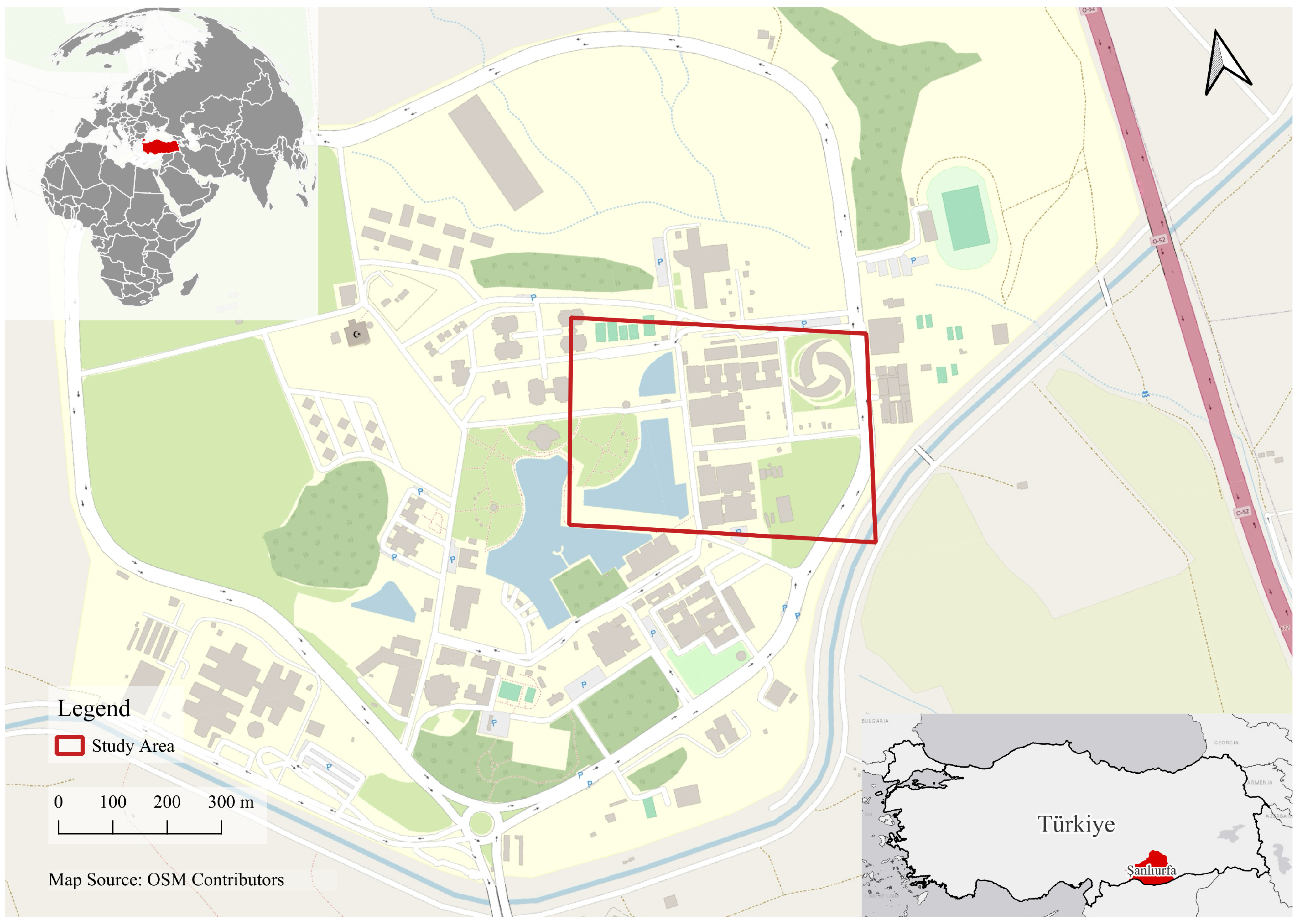
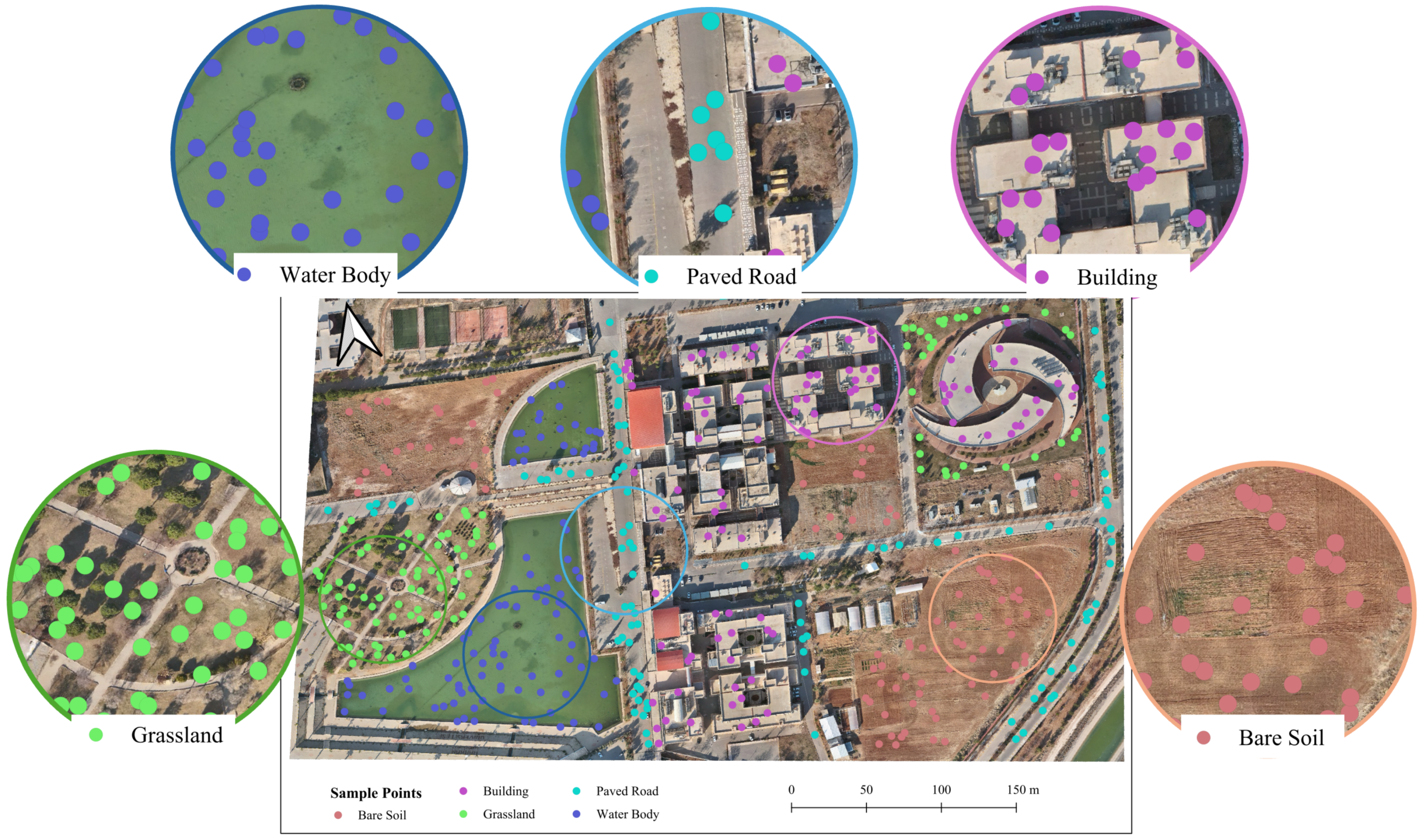
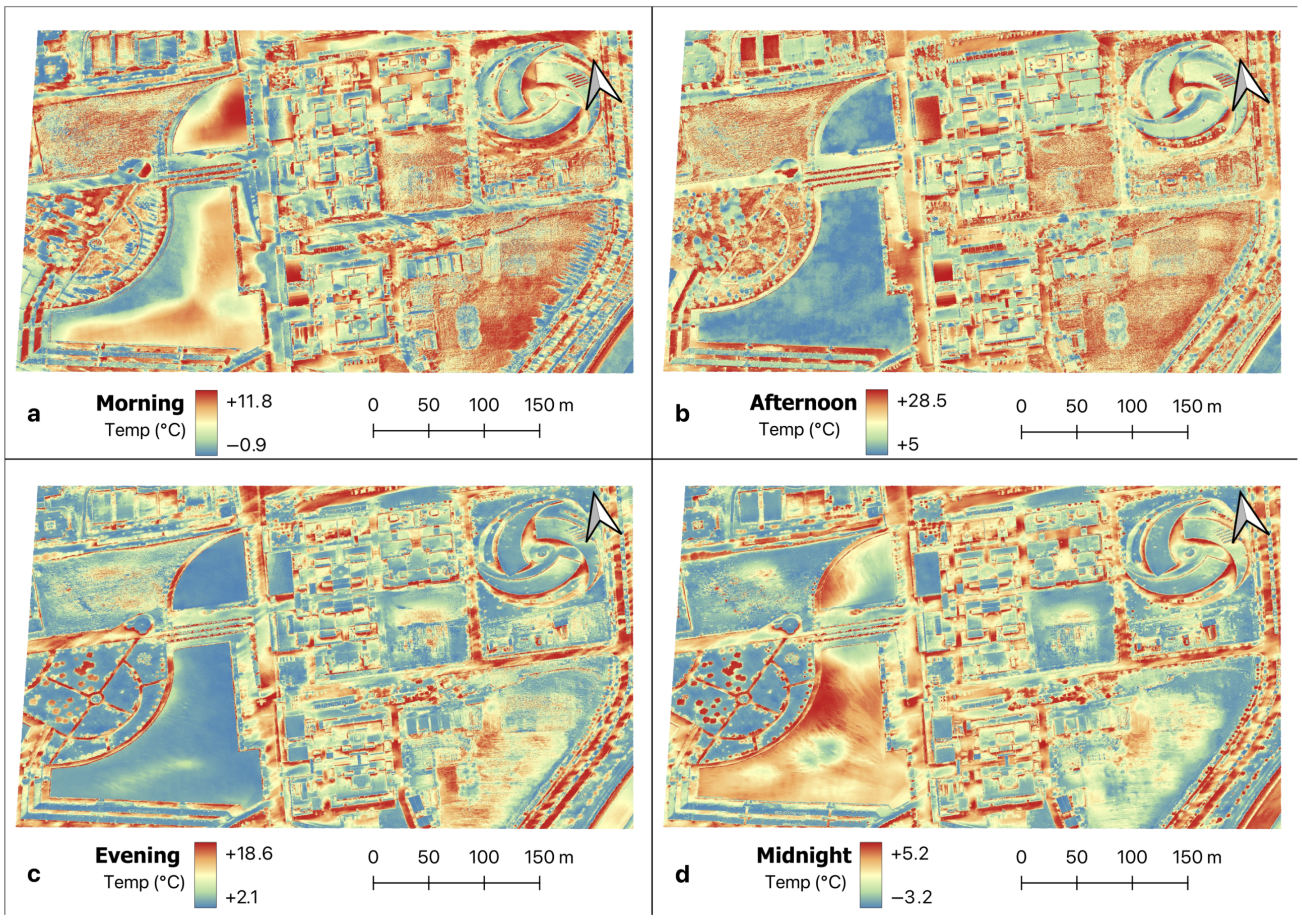
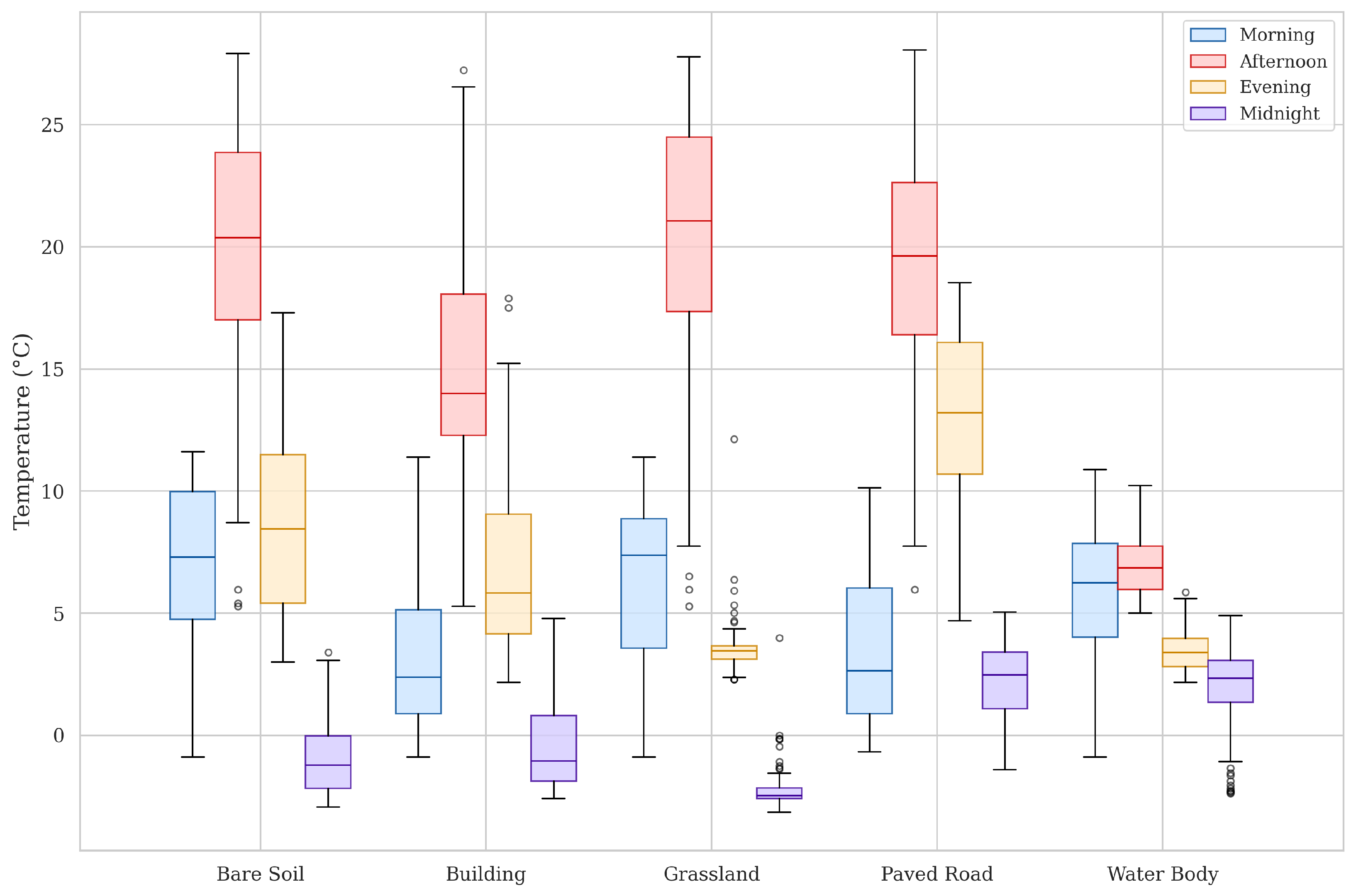
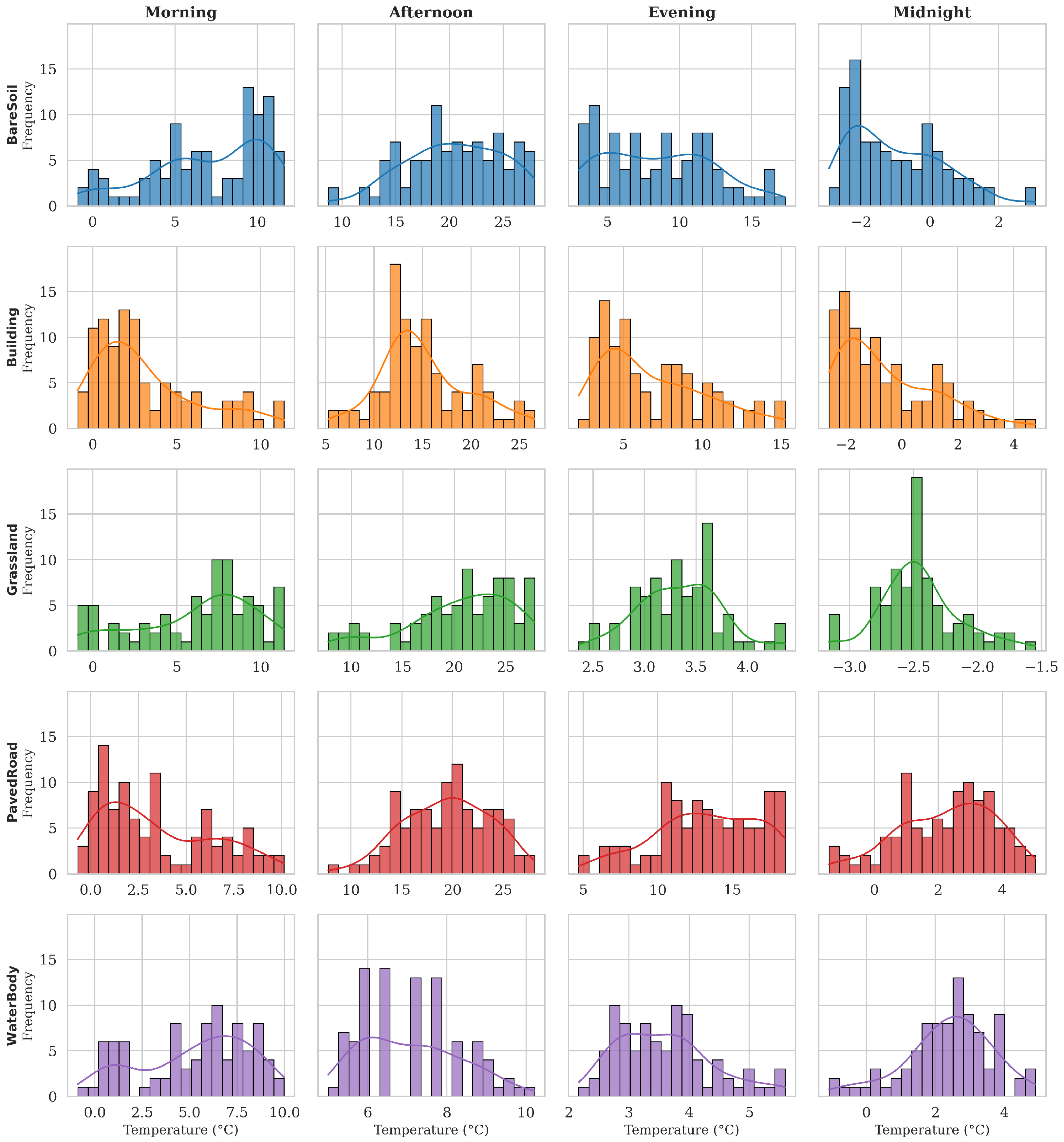
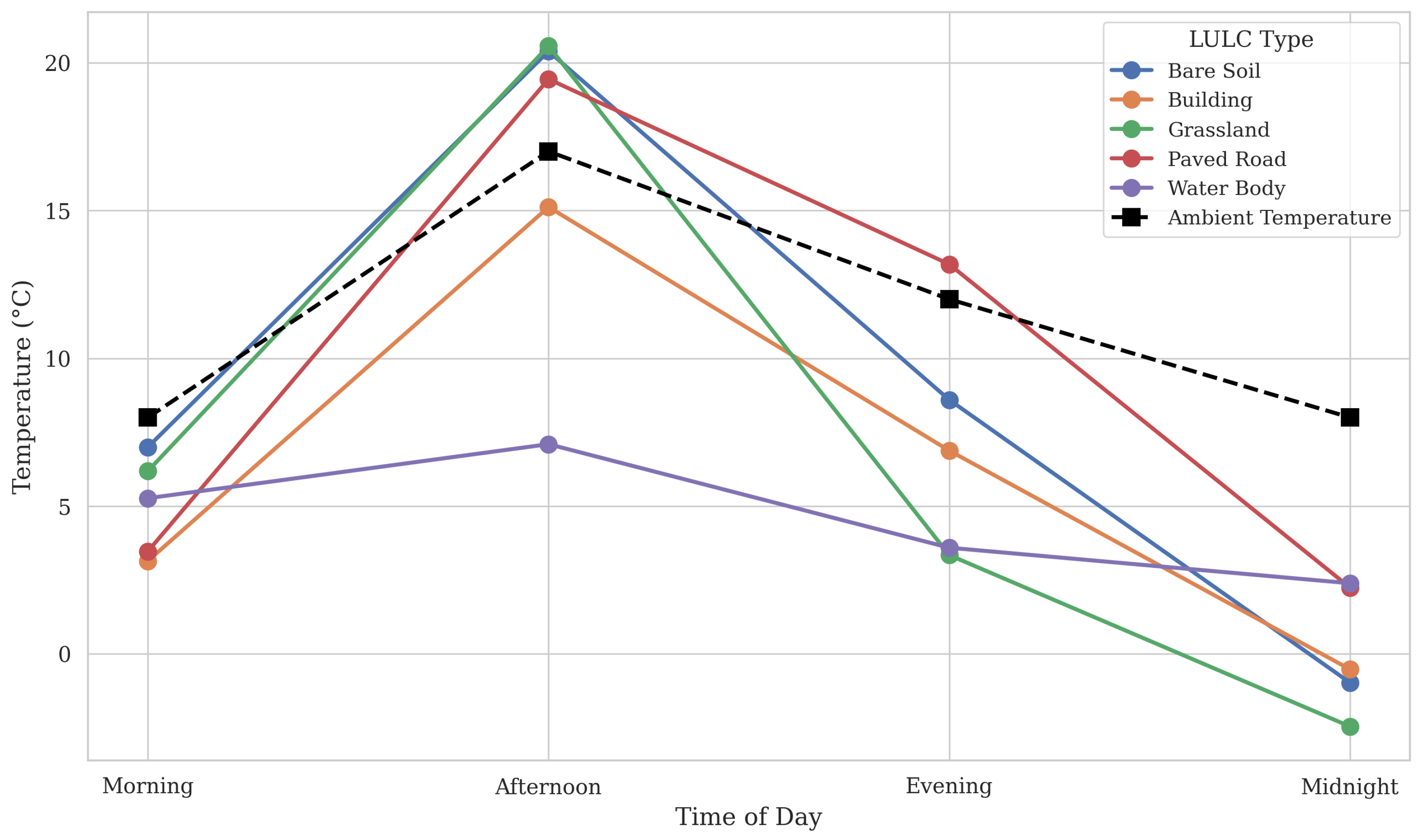
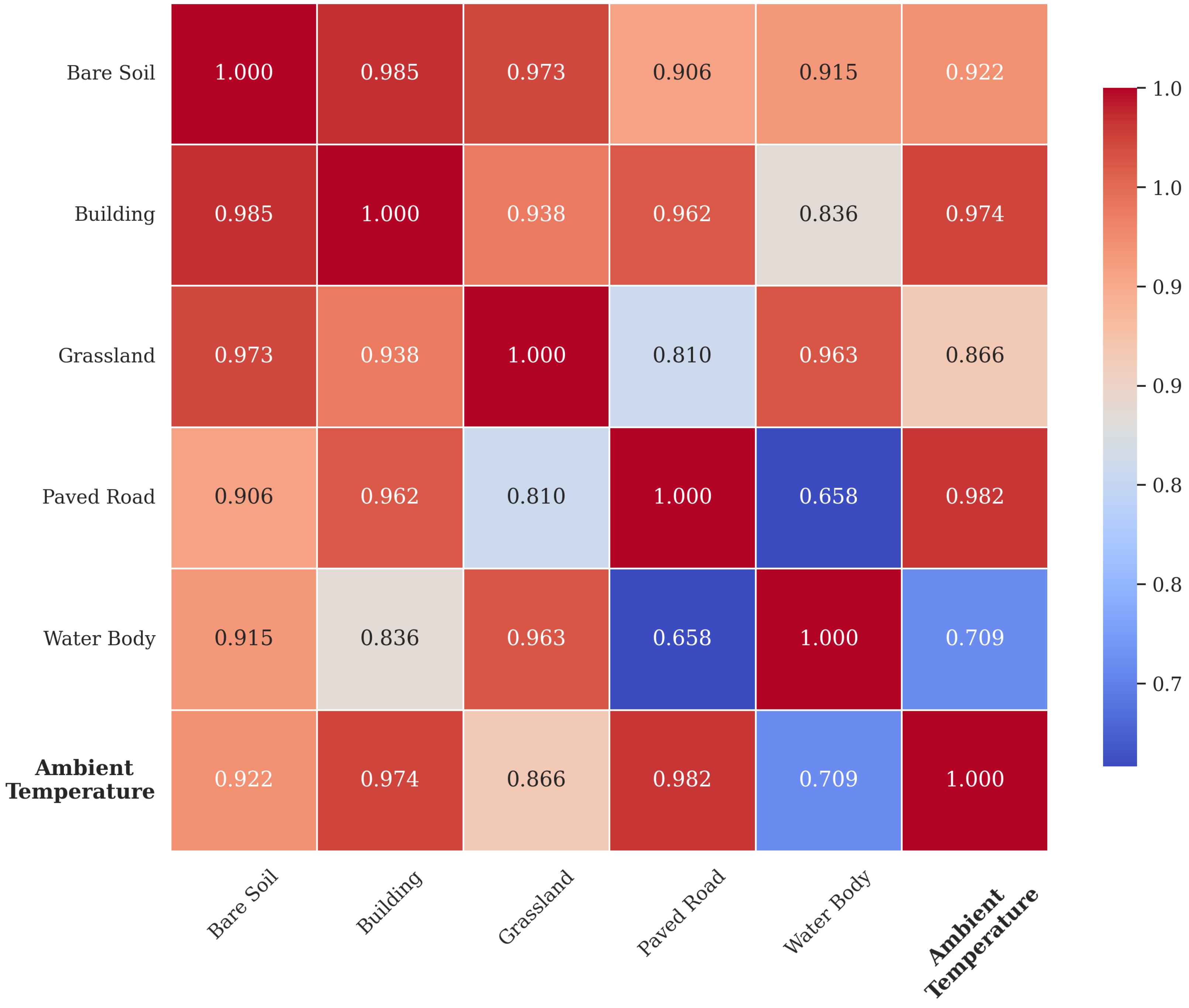

| LULC Class | Temporal Period | n | Mean (°C) | SD | Median (°C) | Min | Max |
|---|---|---|---|---|---|---|---|
| Bare Soil | Morning | 96 | 7.00 | 3.45 | 7.45 | −0.90 | 11.62 |
| Afternoon | 96 | 20.39 | 4.50 | 20.78 | 8.71 | 27.92 | |
| Evening | 96 | 8.60 | 3.78 | 8.57 | 3.01 | 17.31 | |
| Midnight | 96 | −0.97 | 1.35 | −1.18 | −2.93 | 3.07 | |
| Building | Morning | 98 | 3.15 | 3.07 | 2.38 | −0.90 | 11.39 |
| Afternoon | 98 | 15.12 | 4.54 | 14.06 | 5.27 | 26.55 | |
| Evening | 98 | 6.88 | 3.29 | 5.79 | 2.16 | 15.24 | |
| Midnight | 98 | −0.52 | 1.71 | −1.05 | −2.60 | 4.78 | |
| Grassland | Morning | 81 | 6.19 | 3.49 | 7.37 | −0.90 | 11.39 |
| Afternoon | 81 | 20.57 | 5.13 | 21.33 | 7.75 | 27.78 | |
| Evening | 81 | 3.34 | 0.41 | 3.33 | 2.36 | 4.36 | |
| Midnight | 81 | −2.45 | 0.31 | −2.50 | −3.16 | −1.55 | |
| Paved Road | Morning | 99 | 3.47 | 2.92 | 2.75 | −0.68 | 10.13 |
| Afternoon | 99 | 19.45 | 4.22 | 19.69 | 7.75 | 28.06 | |
| Evening | 99 | 13.18 | 3.49 | 13.23 | 4.69 | 18.54 | |
| Midnight | 99 | 2.25 | 1.51 | 2.47 | −1.41 | 5.04 | |
| Water Body | Morning | 89 | 5.27 | 2.85 | 5.95 | −0.90 | 9.98 |
| Afternoon | 89 | 7.10 | 1.25 | 7.20 | 5.00 | 10.22 | |
| Evening | 89 | 3.59 | 0.79 | 3.52 | 2.16 | 5.59 | |
| Midnight | 89 | 2.39 | 1.25 | 2.60 | −1.08 | 4.91 |
| Time Period | Moran’s I | p-Value | Interpretation |
|---|---|---|---|
| Morning | 0.278 | 0.001 | Moderate clustering |
| Afternoon | 0.560 | 0.001 | Strong clustering |
| Evening | 0.592 | 0.001 | Strong clustering |
| Midnight | 0.604 | 0.001 | Strong clustering |
| LULC Class | Timeframe | Bandwidth | Adjusted R2 |
|---|---|---|---|
| Bare Soil | Morning | 67.0 | 0.142 |
| Afternoon | 94.0 | −0.053 | |
| Evening | 81.0 | 0.515 | |
| Midnight | 73.0 | 0.460 | |
| Building | Morning | 79.0 | 0.149 |
| Afternoon | 80.0 | 0.162 | |
| Evening | 94.0 | 0.231 | |
| Midnight | 86.0 | 0.255 | |
| Grassland | Morning | 80.0 | 0.057 |
| Afternoon | 77.0 | 0.227 | |
| Evening | 80.0 | 0.030 | |
| Midnight | 80.0 | −0.010 | |
| Paved Road | Morning | 57.0 | 0.246 |
| Afternoon | 92.0 | 0.403 | |
| Evening | 81.0 | 0.567 | |
| Midnight | 76.0 | 0.514 | |
| Water Body | Morning | 53.0 | 0.617 |
| Afternoon | 57.0 | 0.339 | |
| Evening | 57.0 | 0.638 | |
| Midnight | 53.0 | 0.550 |
| LULC Class | Morning to Afternoon | Afternoon to Evening | Evening to Midnight | Mean Adjusted |
|---|---|---|---|---|
| Bare Soil | −137.3% | +1071.7% | −10.7% | 0.266 |
| Building | +8.7% | +42.6% | +10.4% | 0.199 |
| Grassland | +298.2% | −86.8% | −133.3% | 0.076 |
| Paved Road | +63.8% | +40.7% | −9.3% | 0.433 |
| Water Body | −45.1% | +88.2% | −13.8% | 0.536 |
Disclaimer/Publisher’s Note: The statements, opinions and data contained in all publications are solely those of the individual author(s) and contributor(s) and not of MDPI and/or the editor(s). MDPI and/or the editor(s) disclaim responsibility for any injury to people or property resulting from any ideas, methods, instructions or products referred to in the content. |
© 2025 by the authors. Licensee MDPI, Basel, Switzerland. This article is an open access article distributed under the terms and conditions of the Creative Commons Attribution (CC BY) license (https://creativecommons.org/licenses/by/4.0/).
Share and Cite
Polat, N.; Memduhoğlu, A. Assessing Spatiotemporal LST Variations in Urban Landscapes Using Diurnal UAV Thermography. Appl. Sci. 2025, 15, 3448. https://doi.org/10.3390/app15073448
Polat N, Memduhoğlu A. Assessing Spatiotemporal LST Variations in Urban Landscapes Using Diurnal UAV Thermography. Applied Sciences. 2025; 15(7):3448. https://doi.org/10.3390/app15073448
Chicago/Turabian StylePolat, Nizar, and Abdulkadir Memduhoğlu. 2025. "Assessing Spatiotemporal LST Variations in Urban Landscapes Using Diurnal UAV Thermography" Applied Sciences 15, no. 7: 3448. https://doi.org/10.3390/app15073448
APA StylePolat, N., & Memduhoğlu, A. (2025). Assessing Spatiotemporal LST Variations in Urban Landscapes Using Diurnal UAV Thermography. Applied Sciences, 15(7), 3448. https://doi.org/10.3390/app15073448









